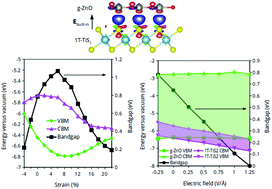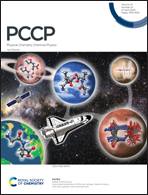Tunable electronic properties of the novel g-ZnO/1T-TiS2 vdW heterostructure by electric field and strain: crossovers in bandgap and band alignment types†
Abstract
A relatively new and promising method to tune properties of monolayers is by forming a heterostructure of them. Here, the van der Waals heterostructure of graphene-like zinc oxide (g-ZnO) and 1-trigonal titanium disulfide (1T-TiS2) was formed and its structural, electronic, and optical properties were studied in the framework of density functional theory. The dynamical stability of the heterostructure was confirmed based on its phonon band structure. An indirect (Γ → M) bandgap of 0.65 eV, a large built-in electric field (or a large potential drop of 3.12 eV), a type-II (staggered) band alignment, and a large conduction band offset of 2.94 eV were found to form across the interface, which are all desirable for potentially efficient separation of charge carriers. We showed also that the formation of the heterostructure largely enhances the almost-zero optical absorption of g-ZnO in visible and near-infrared regions, which is desirable for optoelectronic applications. By applying a perpendicular electric field, we could tune the bandgap value and the band alignment type (type-II → type-I) of the heterostructure. Finally, we showed that by applying compressive strain, one can change the band alignment type (type-II → type-I) and by applying tensile strain, the bandgap value could be tuned and a crossover occurs in the bandgap type (indirect → direct → indirect).



 Please wait while we load your content...
Please wait while we load your content...